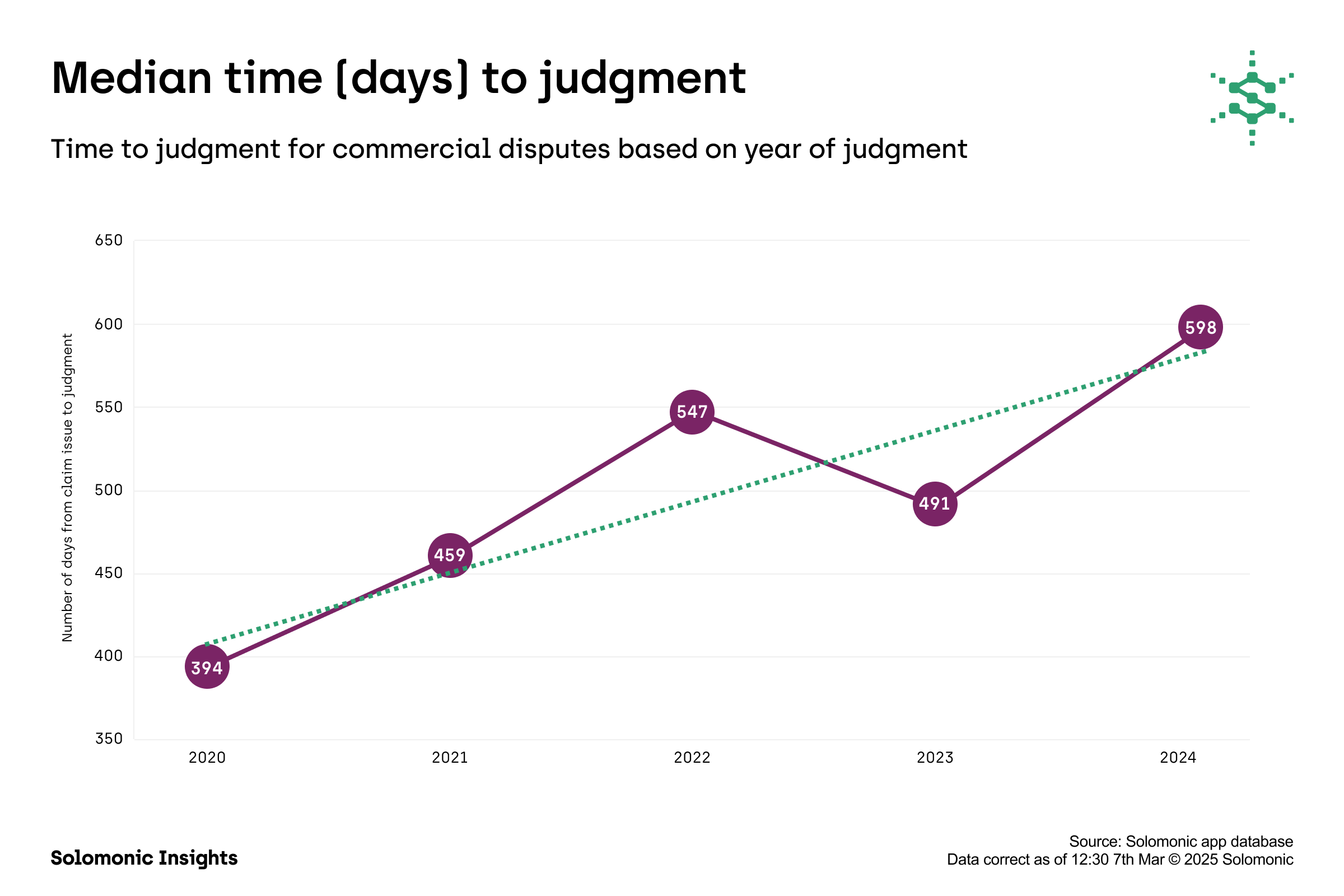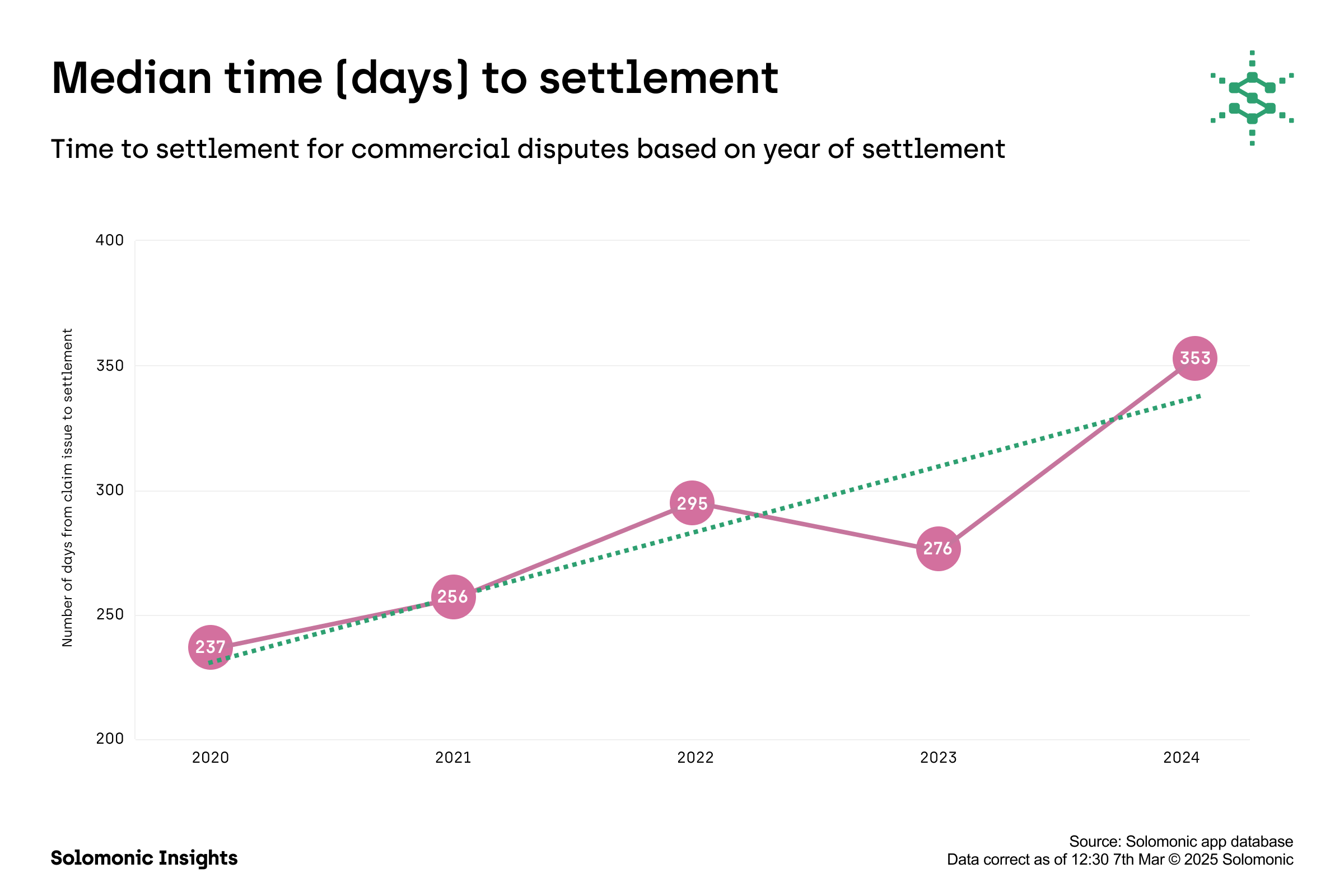How litigation data and eDiscovery drive successful commercial dispute strategies
From data to action: Solomonic’s commercial disputes data outlines trends in the courts over the past five years and eDiscovery provider Everlaw provides insights into how practitioners translate these trends into action to master growing case volumes and unlock better client outcomes.
In today’s complex legal landscape, staying ahead of litigation trends is more critical than ever. High Court claims data reveal emerging patterns in case volume, duration and settlement, but understanding these trends is only part of the equation. Legal teams need the right toolset and strategies to respond effectively.
To bridge this gap, litigation intelligence platform Solomonic and leading eDiscovery software provider Everlaw have joined forces to demonstrate how a data-driven approach to dispute resolution delivers legal mastery - equipping law firms and corporate legal teams with the insights and tools they need to manage litigation with confidence.
A litigation logjam?
Solomonic data shows that claim volumes have remained relatively stable over the past five years, with fluctuations primarily due to major crises, scandals or geopolitical events. Seasonal patterns persist, with lower claim volumes at the start of the year and a peak in September as litigators return from the summer slowdown.
However, while claims issued during a period is one indicator of litigation activity, it only tells half the story. 2024 saw the highest volume of active cases in five years, with a substantial chunk of these between 19 months and 3 years old. Approximately 5,100 cases fall within this category, representing 27.4% of all active litigation - nearly double the proportion seen in 2020 and 90% above the previous four-year average. Claims of 13-18 months in duration show a similar pattern, while the volume of much older cases declined.
We asked Regional Director, UK & Europe at Everlaw, Chioma Wigwe, who commented: “The increasing volume of ongoing claims highlights the need for faster, smarter resolution. The right set of tools can help legal teams find influential evidence and shape litigation strategy early on, helping counsel make decisive moves earlier. Ultimately, this can help reduce the bottleneck and open a path to swifter resolution.”
Claims are taking longer to resolve
Time to resolution is steadily increasing, placing additional strain on the system. Litigation has never been a swift process, but Solomonic data indicates a significant upward trend in claim duration for commercial disputes. Cases are now taking significantly longer to conclude than they did just a few years ago.
For commercial disputes, the median time to judgment has risen from 394 days in 2020 to 598 days in 2024. Notably, the Commercial Court, which handles many high-value disputes, has seen one of the largest increases, with the median time to judgment rising from 450 days in 2020 to 786 days in 2024. The Business List has also slowed, with median resolution times increasing from 570 days to 661 days over the same period.
Wigwe said: “Many components to litigation add to these extended timelines, including the growing complexity of commercial litigation that require extensive discovery, and judicial capacity constraints. A rise in large-scale trials, which demand extensive resources, could also be exacerbating delays.
Longer case durations create challenges for legal teams managing high-stakes litigation. There is a clear need to expedite the discovery process. By automating document review and analysis, legal teams can devote more resources to pushing cases forward. Tools like Everlaw accelerate document review, surface critical insights faster and allow teams to refine their case strategies more effectively.”
A slowdown in settlements
Solomonic data also shows that time to settlement is increasing for commercial disputes. Prolonged settlement times can increase costs and create added pressure on clients, while a faster resolution process is often preferable, particularly in periods of economic volatility.
The Business List and Commercial Court have seen some of the most pronounced increases, which may point to procedural delays, prolonged negotiations, or increased judicial workloads. If this trend persists, it could strain court efficiency and discourage early settlements. By leveraging data-driven insights, firms can identify opportunities for early resolution and avoid prolonged disputes.
Wigwe commented: “Prolonged settlement times highlight the importance of early case assessment and proactive litigation planning. AI-powered discovery tools allow legal teams to quickly analyse case data, assess strengths and weaknesses and determine the optimal litigation position.”
So how can data and eDiscovery help?
The latest High Court trends highlight a growing backlog of unresolved cases, an increase in litigation duration and shifting settlement patterns - all of which pose challenges for legal teams and the courts. With resources stretched and delays mounting, the ability to process case data efficiently and make informed decisions has never been more critical.
With Solomonic you can:
Manage stakeholder expectations: As exemplified, litigation data can highlight patterns in case outcomes, timelines and judicial behaviour, reducing uncertainty and giving practitioners a baseline for their advice.
Optimise case strategy: By analysing historical case data, legal teams can estimate the likely duration and outcome of a case. This can help in identifying settlement opportunities, planning trial strategies and anticipating the behaviour of opposing parties based on past trends.
At the same time, Everlaw allows practitioners to:
Automate discovery and document review: Streamline processes and eliminate manual tasks with unprecedented automation. Everlaw allows legal teams to take control of the entire eDiscovery process, from data upload and processing to search, review, and production, all the way to trial preparation.
Understand key data: Everlaw helps practitioners turn the burden of data into an asset. With advanced analytics, data visualisation, and groundbreaking machine learning any legal professional can use, identifying and acting on key information has never been easier.
Build the strongest case: With an integrated, collaborative platform, legal teams can work together to craft narratives, organise arguments, analyse evidence and manage the end-to-end process of investigations or litigation.
With the proper tools, like Solomonic and Everlaw, legal teams can take mastery over today's growing case volumes, extract key insights more efficiently and develop data-driven litigation strategies and ultimately improve outcomes for clients.
For time to judgment/settlement, the following commercial courts have been analysed and aggregated: Business List, Financial List, Competition List, Financial Services, Intellectual Property, Pensions List, Revenue List, Admiralty, Circuit Commercial, Commercial, Media and Communications List, Technology and Construction
Solomonic’s analysis includes all publicly available King’s Bench and Chancery Division claims, such as (but not limited to) the electronic court filing service or published judgments. This does not include claims that are not publicly available. Official statistics are published periodically by the Courts and Tribunal Service. The Commercial Court annual report for 2022-23 can be found here: https://www.judiciary.uk/guidance-and-resources/commercial-court-annual-report-2022-2023-published/
At the time of publication, Solomonic has not extended its analysis to include judgments from King’s Bench Appeals, Chancery Appeals, and the Property, Trusts and Probate List.




